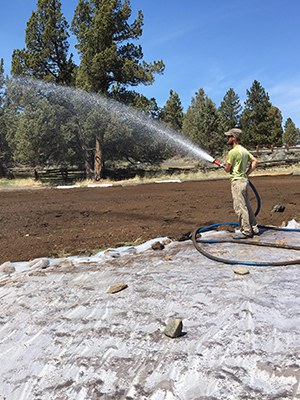
Soil solarization is the process of using the sun’s powerful energy to bake the soil under a layer of plastic to kill a pest or weed. In this case, the Land Trust is working to kill weeds and weed seeds that have been in the soil for around 150 years!
Solarization, while labor intensive, is an effective way to kill weeds and suppress germination of weed seeds far longer than many herbicides. So, how does solarization work?
- First we till the soil and remove any dead plants (primarily last year’s dried weeds).
- Then, we level and smooth the soil surface. We want to make sure the plastic lays flat on the surface of the soil removing any air pockets that might insulate the soil from the heat we are trying to create.
- Next, we wet the soil. Wetting the soil increases its heat conductivity.
- Then, we spread clear plastic over the soil and secure the edges to trap heat and create a greenhouse effect.
- Then we bake! We will be leaving this clear plastic on the ground all spring and summer long and remove it this fall.
- Then, we plant! In the fall, we will remove the plastic and plant native plants. We plan on planting 5,000 new native plants and spreading 20 pounds of native seed and we'll need your help. Watch our volunteer page to sign up for planting parties!
- Finally, we tend and care for our plants. For the first few years, we will need to water our plants until their roots are established and pull any weeds that pop up. Both of these efforts will help ensure the native plants are successful and can out-compete the weeds!
We look forward to seeing how our soil solarization works. Our hope is that we can make a dent in the massive weed bank that has been at Hindman Springs for 150 years (remember your Preserve history and that way station on the Santiam Wagon Road and modern day ranch?). And, in the process, we can hopefully give the native plants would have historically been in the area a leg up and a chance to thrive.
About the Hindman Springs Preservation and Restoration
This soil solarization project is part of a larger effort to preserve and restore the historic Hindman Springs portion of Camp Polk Meadow Preserve. We re-built the Hindman Springs Area trail in August of 2017, stabilized the Hindman barn in January of 2018, and will work to restore native vegetation over the next several years.
Many thanks to the Oregon Community Foundation Historic Trails Fund, the Roundhouse Foundation, the Laird Norton Foundation, East Cascade Audubon Society, and private donors for making the Hindman Springs Area Preservation and Restoration possible.
Learn more:
- About the history of Camp Polk Meadow Preserve
- About the Santiam Wagon Road
- About Camp Polk Meadow Preserve
- Guided hikes at Camp Polk Meadow Preserve


